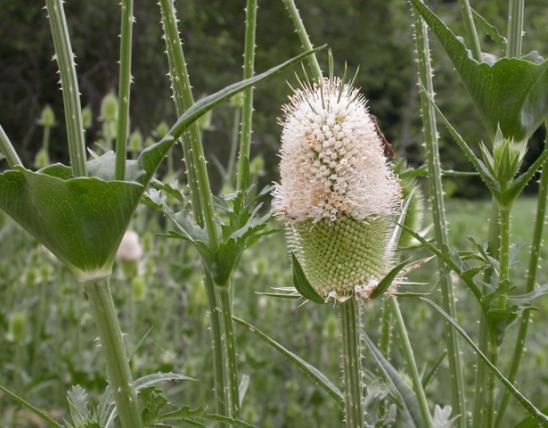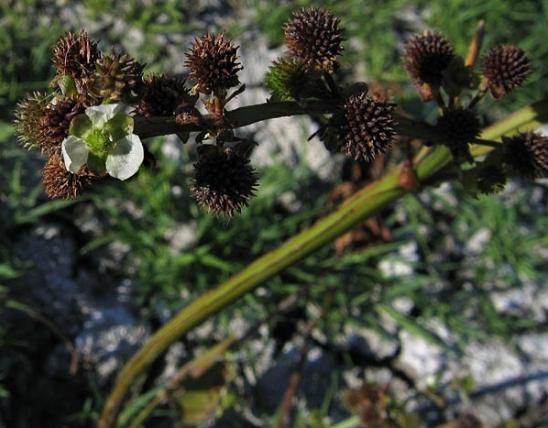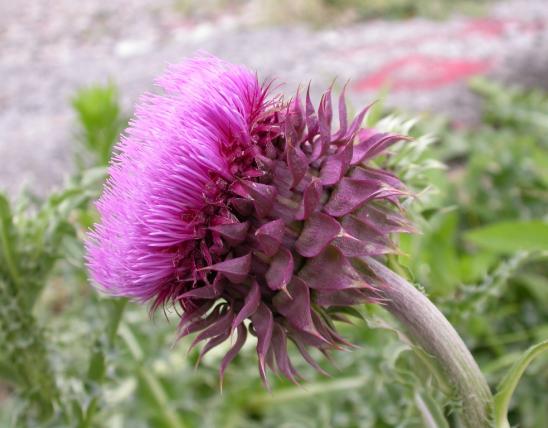
Common cocklebur, or rough cocklebur, is an annual, taprooted plant that usually grows to about 4 feet high. The single, stout stem is green, often speckled with purple, finely ridged or grooved, often with hairs, and usually has only a few side branches.
Leaves are alternate, simple, and have long leaf stems that are often purplish. Blades, overall, are broadly ovate, ovate-triangular, or fairly kidney shaped or circular; the base is often heart-shaped, the tip pointed; the blades may be unlobed or with 3 or 5 shallow, wide, palmate lobes. Margins are coarsely and irregularly toothed. The surfaces are roughened with hairs.
Flowerheads are either male or female, both occurring on the same plant and arising where the leaves attach to the stem. The flowers are composite flowerheads, as in other plants in the sunflower/daisy family. Male flowerheads (that produce only pollen) occur in a small cluster at the tips of the flower stalks; they are small, saucer-shaped, and whitish. The male flowers are inconspicuous and fall away once they have shed their pollen. The female flowerheads (which become the burs) are positioned in small clusters beneath the male flower clusters. Each compound female flowerhead contains 2 florets that are almost completely enclosed in a prickly bract that will become the outside of the bur. As the fruits mature, they go from green to brown. Because the flowers are pollinated by wind, the flowers have no nectar and no scent. Blooms July–November.
Fruits are the familiar brown, ½–1 inch long, egg-shaped cockleburs covered with hooked spines, with 2 rather prominent beaks on the outer tip that are somewhat incurved at the tips. There can be more than 2,000 cockleburs on a single plant.
Similar species: In the past, genus Xanthium used to be considered a diverse genus, with hundreds of species worldwide. Botanists used arcane differences in the form of the burs to separate these plants. Today, botanists have boiled it down to about a dozen, or even just three, species globally. The characteristics formerly used to separate what people thought were species represent a fairly fluid variation within the few actual species. Thus older references may show Missouri having up to eight species of cockleburs; today it’s only two.
Of the two species of Xanthium recorded for Missouri, common cocklebur is by far the most common. The other species, spiny cocklebur (X. spinosum), is known only from historical collections from St. Louis — but note that it has been found elsewhere in the Midwest. Identify it by the presence of 3-parted spines on the plant stalks where the leaves attach; lance-shaped leaves; and the burs’ lack of paired beaks (they either have a single, short, straight beak or else lack one entirely).
Plenty of other plants have fruits covered with spines or little hooks. Of these, the one most similar to cocklebur is common or lesser burdock (Arctium minus); it is an introduced member of the aster/sunflower family that occurs sporadically statewide. It has pinkish-purple flowers that peek out of the tip of the rounded, spiny, thistle-like green involucres whose spines curl back into hooks.
Height: 4–60 inches (rarely, to 78 inches).
Scattered to common statewide. Occurs nearly worldwide.
Habitat and Conservation
Common cocklebur prefers open lowlands or bottomlands and moist, open, disturbed places: banks of streams, rivers, and spring branches, swamps, sloughs, bottomland prairies, bottomland forest, and margins of ponds, lakes, sinkhole ponds, marshes, fens, and seeps; also fallow fields, crop fields, pastures, barnyards, ditches, railroads, roadsides, and open disturbed areas.
Ecologically, cockleburs are a colonizer of disturbed open-soil habitats. They have an interesting strategy for reproduction: of the two seeds (fruits) within each bur, one is generally bigger and germinates quickly (the next spring after it had flowered), while the second seed is smaller and essentially waits to germinate (usually the second year) in case the first seedling fails to survive.
Because it is a global crop weed, common cocklebur has received a lot of attention from agricultural scientists. They have uncovered a lot of interesting information about how this species lives, such as: cocklebur generally doesn’t grow and bloom in full shade; it doesn’t begin the physiological and biochemical processes of starting to bloom until after the day length shortens in fall; its seeds germinate best at specific depths in the soil; the seeds rarely germinate when they’re lying on top of the soil; and so on.
Status
Native Missouri forb. Usually considered an agricultural weed.
Many scientists believe that common cocklebur probably originated in North America and that it has been naturalized on other continents. Other scientists say it originated in Central or South America.
Human Connections
Ouch! They’re spiny. Handle cockleburs with care.
Considered a weed in crop fields, including Missouri’s many corn, soybean, and cotton fields. In Southeast Asia, it causes headaches for rice growers. Young cocklebur plants exude chemicals that prevent other plants from germinating or growing nearby.
Considered a nuisance to livestock. The spines can injure the mouths and other sensitive tissues of cattle and horses that attempt to feed on it — even though livestock generally find it unpalatable. If livestock eat them in quantities, the burs may also cause blockages in the throat and intestines.
The burs become entangled in the fur of farm animals and pets, irritating and possibly wounding the skin. When the burs get caught in the wool of sheep, it can reduce the value of the wool by lowering the wool’s quality or by adding to the work of processing.
Another reason cocklebur is unwelcome among farmers is that young seedling cocklebur plants and seeds contain extremely toxic compounds that can poison mammals and birds when ingested at even low concentrations.
Older plants, however, have long been considered edible or medicinal by many human cultures worldwide. We cannot recommend eating them.
Cockleburs are nature’s Velcro — in fact, the idea for Velcro came from a plant very similar to cocklebur. The inventor of Velcro, a Swiss engineer named George de Mestral, studied the mechanism that attached burdock fruits to his clothing and to his Irish pointer. Then he recreated the mechanism artificially. At first, his invention was viewed as rather frivolous, but after NASA found it incredibly useful on space flights, the idea caught on. Today, lots of people are looking at the natural world for ideas for new innovations — it’s called biomimetics, or bio-inspired technology. There are many examples, but Velcro is exhibit number one.
“Like a cocklebur under the saddle” or “a bur in your sock” are old sayings with obvious implications. Cockleburs have long been a source of practical jokes. As kids, how many of us had an uncle who showed us cockleburs and tried to convince us they were “porcupine eggs,” which we just had to “sit on and incubate” until they hatched?
Ecosystem Connections
Cockleburs, like ragweeds, are wind-pollinated, so pollinating insects like bees, butterflies, and bee flies are not interested in them. Several insects, however, feed on various parts of the plant. The leaves are eaten by leaf beetles, and leafminer fly larvae chew tunnels within the middle of leaves. The stems are bored into by longhorn beetles, stem weevils (such as the cocklebur weevil), billbugs, tumbling flower beetles, and the larvae of certain types of borer moths. The plant juices are sucked by plant bugs and aphids. The seeds are eaten by at least one type of moth larva. Insects like these are a critical food source for birds, especially during nesting season, when even seed-eating birds switch to meals of insects for the added protein for their growing young.
Even though cockleburs don’t require insects for pollination, they’ve enlisted the help of animals for seed dispersal. This is the story behind the grippy, hooked spines on the surfaces of the burs: once mature, the burs detach readily from the parent plant and get stuck on the fur of mammals. The seeds are transported to a new place away from the parent plant and can begin a new colony elsewhere.
Cockleburs also are frequently transported by water. They typically grow in low areas or along waterways, so streams and floods can move their buoyant burs to new locations as well as animals can.
Although the seeds and seedlings are toxic to mammals and birds, the mature plants are a fairly nutritious food source for deer, elk, and other mammals. Several types of mammals and birds apparently can tolerate the seeds’ toxicity and have been recorded eating them, including finches, ground squirrels, and mice.
The extinct Carolina parakeet — the only member of the parrot family native to eastern North America — used to forage on cocklebur seeds, among other nuts, seeds, and fruits. John James Audubon’s portrait of that species, painted in 1825 and later published in his magnificent Birds of North America, depicts seven Carolina parakeets noshing on common cocklebur. There is speculation that their heavy diet of toxic cocklebur seeds made the parakeets themselves toxic or unpalatable to their predators.
Pioneer plants like cocklebur tend to be weeds in the context of human agriculture, but in nature they serve the important function of colonizing recently disturbed ground — say, in a fresh clearing in the woods after a great tree falls over and tips up a gaping mound of raw earth. Cocklebur and other colonizer plants also help to stabilize stream banks after a flood. They take root and clothe the bare soil, preventing erosion and making the area more hospitable for other plants to get a foothold. Once a disturbed, open area becomes shaded again, the colony of cockleburs will die out. Their offspring must carry on in a new, open area — lucky for them that they have developed a way for their prickly fruits to be transported far and wide.































